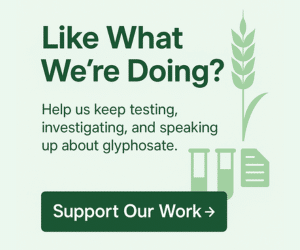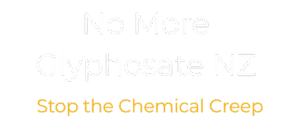You do all the right things. Start the day with good intentions. Maybe it’s organic yogurt and fresh fruit.
Maybe you make your own muesli or pick a store-bought cereal that looks wholesome enough. Either way, it feels like a healthy choice.
But what if that choice comes with an invisible dose of glyphosate? A chemical not listed on any label. A residue no one in New Zealand is testing for.
Because it’s not just about what we choose to eat—it’s about what we’re not being told.
We Check the Sugar. But What About the Spray?
We like to think we’re a country that looks after its own. Especially when it comes to food. But how well are we really doing when the most basic of questions—“What’s in our breakfast cereal?”—goes unanswered?
Across the globe, testing has revealed glyphosate, the world’s most widely used herbicide, showing up in breakfast bowls. Not in trace amounts, either—but in levels that have parents, scientists, and public health advocates deeply concerned.
So, what about here in New Zealand?
We don’t know.
Because no one’s tested. At least, not recently. Not publicly. And certainly not with children’s health front and centre.
See It for Yourself
If you’re wondering what all the fuss is about, this short video breaks it down. From glyphosate’s link to breakfast cereals to why some say it’s a growing health concern, it’s a must-watch for anyone who’s ever poured a bowl of oats without a second thought.
It’s not alarmism—it’s awareness. And it’s worth asking why these conversations are happening overseas, while silence lingers here in New Zealand.
Overseas Testing Sent a Clear Message: Breakfast Isn’t Safe From Herbicides
In 2018, the U.S.-based Environmental Working Group (EWG) conducted independent lab tests on dozens of popular breakfast products—everything from Cheerios and Quaker Oats to granola bars and instant oatmeal.
The results were eye-opening:
Glyphosate was detected in 26 of 28 products tested.
All but two exceeded the EWG’s health benchmark for children’s safety.
This wasn’t fringe food. These were mainstream, family-trusted brands—many marketed directly to children. The same kinds of products lining our supermarket shelves.
Fast forward to 2023, and the EWG repeated the tests. Levels had dropped, possibly in response to consumer pressure. But glyphosate still showed up—even after manufacturers claimed to have phased it out.
These studies weren’t about whether glyphosate was present. They were about how much.
And the uncomfortable answer? Too much for comfort.
Oats, Wheat, and the Pre-Harvest Problem
Why is glyphosate ending up in cereal in the first place?
One word: desiccation.
In many countries—including New Zealand—glyphosate is used not just to kill weeds, but to dry crops right before harvest. This pre-harvest use is especially common with oats, wheat, and barley. Spraying these crops at the end of their growth cycle makes them easier to harvest and process uniformly.
But the downside? Glyphosate residues can remain on the grain as it’s milled, baked, or processed—right into your morning cereal or toast.
And if that grain comes from a country that doesn’t require transparent testing—or one that’s just approved much higher residue limits—you may never know.
Here’s a closer look at how glyphosate gets into our food—and why desiccation matters more than most people realize.
The New Zealand Silence: No Tests, No Data, No Warnings
In New Zealand, the Ministry for Primary Industries (MPI) has not released glyphosate testing data for oat-based products—or breakfast cereals of any kind—in nearly a decade.
The last publicly available survey, conducted in 2015/16, focused on wheat. It found glyphosate in 43% of samples, and a third of those exceeded the legal limit at the time.
That data is now badly outdated. And since then, MPI has proposed increasing the allowable glyphosate levels in some food crops by as much as 100 times—from 0.1 mg/kg to 10 mg/kg.
But here’s the kicker: they haven’t published any recent test results to justify the increase.
That means no updated data on:
- Local or imported oats
- Cereal products
- Breakfast bars
- Muesli
- Multigrain breads
In a country where oats and wheat are dietary staples—and where breakfast cereals dominate children’s diets—that silence is more than troubling. It’s negligent.
A Hidden Exposure Path for Kids
Breakfast is where many kids get their first, and often largest, daily calorie intake. A bowl of cereal, a slice of toast, maybe a granola bar tucked into a school lunchbox. It’s also where they may be exposed to low-dose chemical residues day after day.
Even if these residues fall under what’s legally allowed, it doesn’t mean they’re harmless—especially for growing bodies.
The International Agency for Research on Cancer (IARC), a branch of the WHO, classified glyphosate as a “probable human carcinogen” in 2015. That classification still stands. And yet New Zealand regulators continue to claim glyphosate is safe—without fresh, publicly available data to prove it.
So we ask: if glyphosate is showing up in U.S. and European cereals, why wouldn’t it be here?
The real question is: Why aren’t we looking?
So We’re Looking
No More Glyphosate NZ has already begun independent testing—starting with honey, where glyphosate residues have been known to trigger international export rejections.
Next, we’ll be testing wheat and oat-based cereals and breads sold in New Zealand supermarkets. Not just to see if glyphosate is present—but to ask how much, and whether it exceeds limits accepted by countries like Japan or the EU.
Because we believe the public deserves better than guesses.
Look for the “Test Series” banners across our site as new results are published.
Donate today to help us expand the testing.
Join our mailing list to be notified when cereal results go live.
We’re doing the job our regulators won’t.
Final Thought: If It’s Not in the Data, It’s Not in the Debate
The glyphosate conversation in New Zealand has been dominated by regulatory soundbites and theoretical safety margins. But that’s not enough.
Data drives decisions.
And right now, New Zealand’s breakfast food safety data is running on empty.
If glyphosate is ending up in our cereals, we need to know.
If it isn’t, great—let’s prove it.
But until then, “no evidence of harm” means little when there’s no evidence at all.
Resources & References
The breakfast aisle is where many of us reach for convenience—but it may also be where hidden chemical exposures begin. These references highlight the growing global concern about glyphosate in cereals, particularly those aimed at children, and why New Zealand should be paying closer attention.
EWG – “Roundup for Breakfast Part 2”
https://www.ewg.org/news-insights/news-release/2018/10/roundup-breakfast-part-2-new-tests-weed-killer-found-all-kids
Follow-up testing found glyphosate in nearly every U.S. oat-based product tested, including major brands aimed at children.
EWG – “Going, Going, Gone? Glyphosate Levels Drop in Oat-Based Products”
https://www.ewg.org/news-insights/news/2023/04/going-going-gone-ewg-finds-glyphosate-levels-drop-oat-based-products
Glyphosate residues decreased in some products by 2023—but were still detectable in several, suggesting incomplete reformulation efforts.
YouTube – “Glyphosate in Cereal: What’s In Your Breakfast Bowl?”
https://www.youtube.com/watch?v=dycsFm7ek34&t=55s
A short, accessible video summary of glyphosate’s presence in cereals and why consumer concern continues.
Ministry for Primary Industries (NZ) – MRL Consultation Documents
https://www.mpi.govt.nz/consultations/proposed-amendments-to-the-new-zealand-food-notice-maximum-residue-levels-for-agricultural-compounds/
MPI’s proposal to increase allowable glyphosate residue limits in oats, wheat, and other key crops—without current testing data to support it.
These sources don’t just raise alarms—they raise important questions. If glyphosate is turning up in cereal boxes around the world, why wouldn’t it be in ours? And more importantly—why aren’t we checking?
Image Source & Attribution
We’re grateful to the talented photographers and designers whose work enhances our content. The feature image on this page is by gpointstudio.




